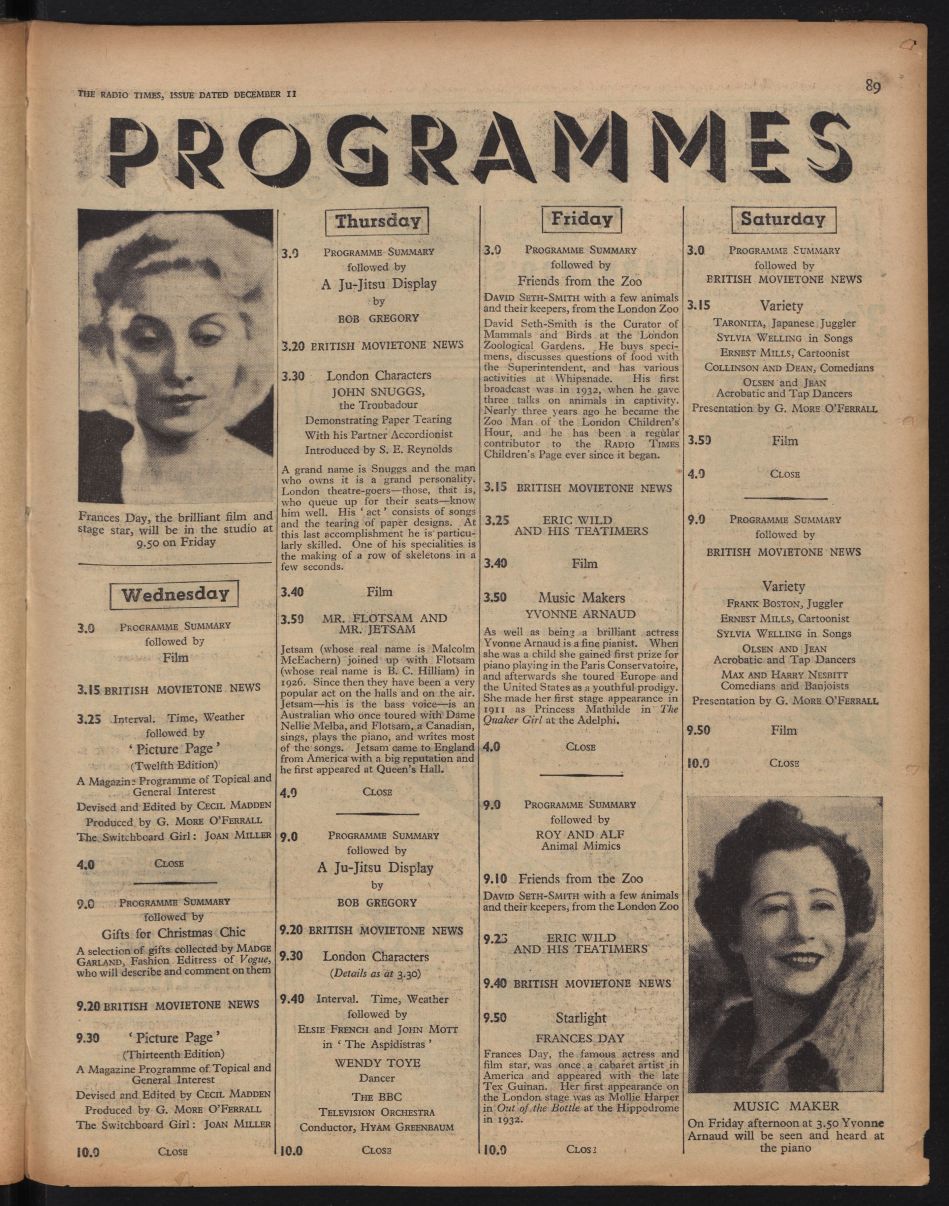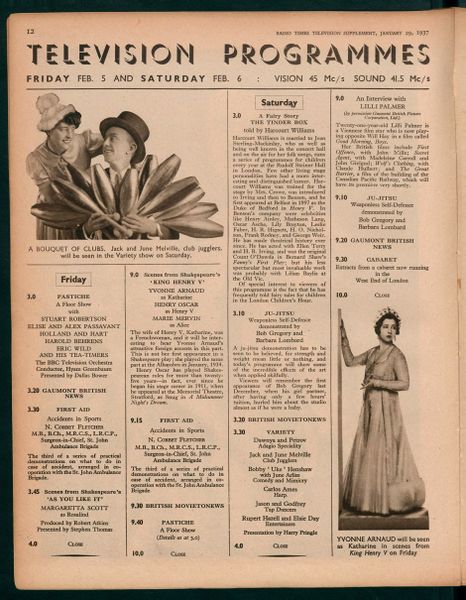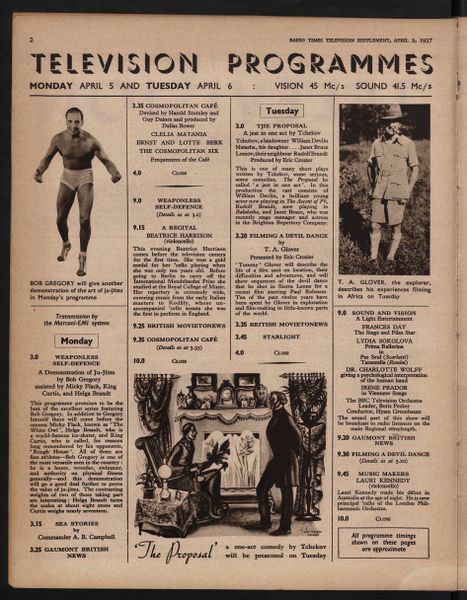Weaponless Self-Defence (lost early ju-jitsu television program; 1936-1937): Difference between revisions
(A demonstration on how people, particularly women, can defend themselves, with demonstrations from a few professional wrestlers! Would recommend watching the attached British Pathé video by the way, as it is hilarious.) |
No edit summary |
||
| (One intermediate revision by one other user not shown) | |||
| Line 8: | Line 8: | ||
==Background== | ==Background== | ||
''Weaponless Self-Defence'' was conceptualised during the early days of BBC Television Service, which was looking to broadcast a variety of sports like [[Darts and Shove Ha'penny (lost early BBC televised darts matches; 1936-1939)|darts]] and [[Horace Lindrum vs Willie Smith (lost footage of televised snooker; 1937)|snooker]].<ref>[https://books.google.co.uk/books?id=ZM-GDQAAQBAJ&pg=PA23#v=onepage&q&f=false ''BBC Sport in Black and White'' noting the BBC's desire to broadcast various sports in BBC Television Service's early days.] Retrieved 27th Jan '22</ref> Bob Gregory was selected as the main demonstrator for the show, having been an expert in ju-jitsu, and also achieving success in sports like boxing, professional wrestling, and swimming.<ref>[https:// | ''Weaponless Self-Defence'' was conceptualised during the early days of BBC Television Service, which was looking to broadcast a variety of sports like [[Darts and Shove Ha'penny (lost early BBC televised darts matches; 1936-1939)|darts]] and [[Horace Lindrum vs Willie Smith (lost footage of televised snooker; 1937)|snooker]].<ref>[https://books.google.co.uk/books?id=ZM-GDQAAQBAJ&pg=PA23#v=onepage&q&f=false ''BBC Sport in Black and White'' noting the BBC's desire to broadcast various sports in BBC Television Service's early days.] Retrieved 27th Jan '22</ref> Bob Gregory was selected as the main demonstrator for the show, having been an expert in ju-jitsu, and also achieving success in sports like boxing, professional wrestling, and swimming.<ref>[https://wrestlingheritage.co.uk/bob-gregory ''Wrestling Heritage'' detailing the career of Bob Gregory.] Retrieved 27th Jan '22</ref><ref name="genome3">[https://genome.ch.bbc.co.uk/schedules/service_bbc_television_service/1937-04-05#at-15.00 BBC Genome archive of ''Radio Times'' issues detailing the third episode.] Retrieved 27th Jan '22</ref><ref name="radio3">[https://genome.ch.bbc.co.uk/page/bf6303b23ffd40919d0dabe6ff181747?page=42 Issue 705 of ''Radio Times'' listing the third episode.] Retrieved 27th Jan '22</ref> The show had an educational attribute attached to it, considering that not only would Gregory demonstrate the various moves in ju-jitsu, but he would also teach the viewers how to perform the moves themselves, should they require them in a dangerous situation and lacked available weapons.<ref name="genome3"/><ref name="radio3"/> | ||
The first episode was broadcast on 17th December 1936, known simply as ''A Ju-Jitsu Display''.<ref name="genome1">[https://genome.ch.bbc.co.uk/schedules/service_bbc_television_service/1936-12-17#at-15.00 BBC Genome archive of ''Radio Times'' issues detailing the first episode.] Retrieved 27th Jan '22</ref><ref name="radio1">[https://genome.ch.bbc.co.uk/page/8aa4b532ac8a45c386844c3537468545?page=89 Issue 689 of ''Radio Times'' listing the first episode.] Retrieved 27th Jan '22</ref> While issue 689 of ''Radio Times'' did not provide a synopsis of the program,<ref name="genome1"/><ref name="radio1"/> issue 696 states it involved Gregory being tossed around by a female partner, who he had trained for a few hours beforehand.<ref name="genome2">[https://genome.ch.bbc.co.uk/schedules/service_bbc_television_service/1937-02-06#at-15.10 BBC Genome archive of ''Radio Times'' issues detailing the second episode.] Retrieved 27th Jan '22</ref><ref name="radio2">[https://genome.ch.bbc.co.uk/page/2793df9e6c7f4d238b1f5ac230f095da?page=52 BBC Genome archive of ''Radio Times'' issues listing the second episode.] Retrieved 27th Jan '22</ref> The issue noted that she "hurled him about the studio almost as if he were a baby".<ref name="genome2"/><ref name="radio2"/> The second episode was aired on 6th February 1937, featuring Gregory and partner Barbara Lombard, which lasted for ten minutes and repeated later in the day.<ref name="genome2"/><ref name="radio2"/> The last known episode was broadcast on 5th April.<ref name="genome3"/><ref name="radio3"/> Here Gregory worked with fellow professional wrestlers Micky Flack and King Curtis;<ref>[https:// | The first episode was broadcast on 17th December 1936, known simply as ''A Ju-Jitsu Display''.<ref name="genome1">[https://genome.ch.bbc.co.uk/schedules/service_bbc_television_service/1936-12-17#at-15.00 BBC Genome archive of ''Radio Times'' issues detailing the first episode.] Retrieved 27th Jan '22</ref><ref name="radio1">[https://genome.ch.bbc.co.uk/page/8aa4b532ac8a45c386844c3537468545?page=89 Issue 689 of ''Radio Times'' listing the first episode.] Retrieved 27th Jan '22</ref> While issue 689 of ''Radio Times'' did not provide a synopsis of the program,<ref name="genome1"/><ref name="radio1"/> issue 696 states it involved Gregory being tossed around by a female partner, who he had trained for a few hours beforehand.<ref name="genome2">[https://genome.ch.bbc.co.uk/schedules/service_bbc_television_service/1937-02-06#at-15.10 BBC Genome archive of ''Radio Times'' issues detailing the second episode.] Retrieved 27th Jan '22</ref><ref name="radio2">[https://genome.ch.bbc.co.uk/page/2793df9e6c7f4d238b1f5ac230f095da?page=52 BBC Genome archive of ''Radio Times'' issues listing the second episode.] Retrieved 27th Jan '22</ref> The issue noted that she "hurled him about the studio almost as if he were a baby".<ref name="genome2"/><ref name="radio2"/> The second episode was aired on 6th February 1937, featuring Gregory and partner Barbara Lombard, which lasted for ten minutes and repeated later in the day.<ref name="genome2"/><ref name="radio2"/> The last known episode was broadcast on 5th April.<ref name="genome3"/><ref name="radio3"/> Here Gregory worked with fellow professional wrestlers Micky Flack and King Curtis;<ref>[https://wrestlingheritage.co.uk/wwhite.htm ''Wrestling Heritage'' detailing Micky Flack's career, and working with Gregory and Curtis on the show.] Retrieved 27th Jan '22</ref> and Helga Brandt, a professional ice-skater, with issue 705 of ''Radio Times'' noting the weight difference of the eight stone Brandt compared to the seventeen stone Curtis.<ref name="genome3"/><ref name="radio3"/> This was used to further highlight the value of ju-jitsu, with issue 696 noting that the techniques rely little on strength and weight overall, but of skill.<ref name="genome2"/><ref name="radio2"/> | ||
==Availability== | ==Availability== | ||
Like all early television transmissions, the ju-jitsu demonstrations were televised live and there were limited viable means of recording television prior to the Second World War, with recording seldom having occurred until | Like all early television transmissions, the ju-jitsu demonstrations were televised live and there were limited viable means of recording television prior to the Second World War, with recording seldom having occurred until videotape was perfected in the late-1950s.<ref>[https://archive.org/details/BbcTelevisionReceivedInNewYork-1938 ''Web Archive'' article discussing how most early television is missing due to a lack of direct recording of television.] Retrieved 27th Jan '22</ref> Thus, all footage of ''Weaponless Self-Defence'' is likely permanently missing. Nevertheless, Gregory did record a judo demonstration for ''British Pathé'', which was recorded in 1937. It perhaps showcases that ''Weaponless Self-Defence'' was intended primarily for women, with Gregory claiming that while boxing might not be appropriate, judo be would allow a woman to have sufficient means of defending herself against attackers. Additionally, the ''Radio Times'' issues helped to document the show.<ref name="radio1"/><ref name="radio2"/><ref name="radio3"/> | ||
==Gallery== | ==Gallery== | ||
| Line 37: | Line 37: | ||
*[[The Care of Your Car (lost early BBC motoring show; 1947)]] | *[[The Care of Your Car (lost early BBC motoring show; 1947)]] | ||
*[[Cook's Night Out (lost early BBC cooking show; 1937)]] | *[[Cook's Night Out (lost early BBC cooking show; 1937)]] | ||
*[[Craftsmen at Work (lost early BBC documentary show; 1938, 1946)]] | |||
*[[Dish of the Month (lost early BBC cooking show; 1937)]] | *[[Dish of the Month (lost early BBC cooking show; 1937)]] | ||
*[[First Aid (lost early BBC medical show; 1937)]] | *[[First Aid (lost early BBC medical show; 1937)]] | ||
| Line 49: | Line 50: | ||
*[[Telecrime (lost early BBC crime drama; 1938-1939; 1946)]] | *[[Telecrime (lost early BBC crime drama; 1938-1939; 1946)]] | ||
*[[The Wasp's Nest (lost early BBC television adaptation of Agatha Christie short story; 1937)]] | *[[The Wasp's Nest (lost early BBC television adaptation of Agatha Christie short story; 1937)]] | ||
*[[The World of Women (lost early BBC talk show; 1937)]] | |||
===Early BBC Sports Television=== | ===Early BBC Sports Television=== | ||
*[[1931 Epsom Derby (lost televised footage of horse racing event; 1931)]] | *[[1931 Epsom Derby (lost televised footage of horse racing event; 1931)]] | ||
*[[1937 FA Cup Final (partially found footage of football match; 1937)]] | *[[1937 FA Cup Final (partially found footage of football match; 1937)]] | ||
*[[1937 International Imperial Trophy Race (lost footage of motor race; 1937)]] | *[[1937 International Imperial Trophy Race (lost footage of motor race; 1937)]] | ||
| Line 60: | Line 62: | ||
*[[1947 FA Cup Final (partially found footage of football match; 1947)]] | *[[1947 FA Cup Final (partially found footage of football match; 1947)]] | ||
*[[1953 British Grand Prix (partially found footage of Formula One race; 1953)]] | *[[1953 British Grand Prix (partially found footage of Formula One race; 1953)]] | ||
*[[1955 Scottish Cup Final (partially found footage of football match; 1955)]] | |||
*[[Archery (lost early televised toxophily; 1937-1938)]] | |||
*[[Arsenal 7-1 Hibernian (lost footage of charity football match; 1952)]] | |||
*[[Arsenal vs Arsenal Reserves (lost footage of early BBC televised football match; 1937)]] | *[[Arsenal vs Arsenal Reserves (lost footage of early BBC televised football match; 1937)]] | ||
*[[Barnet 3-2 Wealdstone (lost footage of Athenian League football match; 1946)]] | *[[Barnet 3-2 Wealdstone (lost footage of Athenian League football match; 1946)]] | ||
| Line 67: | Line 72: | ||
*[[Darts and Shove Ha'penny (lost early BBC televised darts matches; 1936-1939)]] | *[[Darts and Shove Ha'penny (lost early BBC televised darts matches; 1936-1939)]] | ||
*[[England 0-1 Scotland (partially found international football match; 1938)]] | *[[England 0-1 Scotland (partially found international football match; 1938)]] | ||
*[[England 1-1 Scotland (partially found footage of international football match; 1947)]] | |||
*[[England 16-21 Scotland (partially found footage of rugby match; 1938)]] | *[[England 16-21 Scotland (partially found footage of rugby match; 1938)]] | ||
*[[England 3-0 France (partially found footage of international football match; 1947)]] | |||
*[[England 3-0 Rest of Europe (partially found footage of international football match; 1938)]] | *[[England 3-0 Rest of Europe (partially found footage of international football match; 1938)]] | ||
*[[Falkirk 3-2 Newcastle United (lost footage of football match; 1953)]] | |||
*[[Horace Lindrum vs Willie Smith (lost footage of televised snooker; 1937)]] | *[[Horace Lindrum vs Willie Smith (lost footage of televised snooker; 1937)]] | ||
*[[Scottish Universities 1-1 English Universities (lost footage of international football match; 1952)]] | |||
*[[Woods and Jack (lost early televised lawn bowls; 1937; 1946)]] | |||
==References== | ==References== | ||
Latest revision as of 03:08, 7 July 2022
Weaponless Self-Defence is an early television show broadcast on BBC Television Service from 1936 to 1937. Presented by professional wrestler Bob Gregory, it provided some of the earliest televised demonstrations of ju-jitsu.
Background
Weaponless Self-Defence was conceptualised during the early days of BBC Television Service, which was looking to broadcast a variety of sports like darts and snooker.[1] Bob Gregory was selected as the main demonstrator for the show, having been an expert in ju-jitsu, and also achieving success in sports like boxing, professional wrestling, and swimming.[2][3][4] The show had an educational attribute attached to it, considering that not only would Gregory demonstrate the various moves in ju-jitsu, but he would also teach the viewers how to perform the moves themselves, should they require them in a dangerous situation and lacked available weapons.[3][4]
The first episode was broadcast on 17th December 1936, known simply as A Ju-Jitsu Display.[5][6] While issue 689 of Radio Times did not provide a synopsis of the program,[5][6] issue 696 states it involved Gregory being tossed around by a female partner, who he had trained for a few hours beforehand.[7][8] The issue noted that she "hurled him about the studio almost as if he were a baby".[7][8] The second episode was aired on 6th February 1937, featuring Gregory and partner Barbara Lombard, which lasted for ten minutes and repeated later in the day.[7][8] The last known episode was broadcast on 5th April.[3][4] Here Gregory worked with fellow professional wrestlers Micky Flack and King Curtis;[9] and Helga Brandt, a professional ice-skater, with issue 705 of Radio Times noting the weight difference of the eight stone Brandt compared to the seventeen stone Curtis.[3][4] This was used to further highlight the value of ju-jitsu, with issue 696 noting that the techniques rely little on strength and weight overall, but of skill.[7][8]
Availability
Like all early television transmissions, the ju-jitsu demonstrations were televised live and there were limited viable means of recording television prior to the Second World War, with recording seldom having occurred until videotape was perfected in the late-1950s.[10] Thus, all footage of Weaponless Self-Defence is likely permanently missing. Nevertheless, Gregory did record a judo demonstration for British Pathé, which was recorded in 1937. It perhaps showcases that Weaponless Self-Defence was intended primarily for women, with Gregory claiming that while boxing might not be appropriate, judo be would allow a woman to have sufficient means of defending herself against attackers. Additionally, the Radio Times issues helped to document the show.[6][8][4]
Gallery
Video
Images
See Also
Early BBC Television
- Alexandra Palace's wartime television demonstrations (lost footage of private television transmissions; 1943, 1945)
- An Inspector Calls (lost television adaptation of play; 1948)
- Ann and Harold (lost early BBC drama television series; 1938)
- BBC Election Night (lost coverage of British general elections; 1950-1951)
- The Care of Your Car (lost early BBC motoring show; 1947)
- Cook's Night Out (lost early BBC cooking show; 1937)
- Craftsmen at Work (lost early BBC documentary show; 1938, 1946)
- Dish of the Month (lost early BBC cooking show; 1937)
- First Aid (lost early BBC medical show; 1937)
- Foundations of Cookery (lost early BBC cooking show; 1939)
- Marcel Boulestin television shorts (lost early BBC programs; 1937-1939)
- Masks through the Ages (lost early BBC history talk show; 1937)
- Opening of the BBC Television Service (partially found coverage of inaugural day of high-definition television service; 1936)
- The Orchestra and its Instruments (lost early BBC music talk show; 1937)
- RCA recording of BBC Television Service (found footage of pre-Second World War BBC television broadcast; 1938)
- Sea Stories (lost early BBC talk show; 1936-1937)
- Spelling Bee (lost early BBC game show; 1938)
- Telecrime (lost early BBC crime drama; 1938-1939; 1946)
- The Wasp's Nest (lost early BBC television adaptation of Agatha Christie short story; 1937)
- The World of Women (lost early BBC talk show; 1937)
Early BBC Sports Television
- 1931 Epsom Derby (lost televised footage of horse racing event; 1931)
- 1937 FA Cup Final (partially found footage of football match; 1937)
- 1937 International Imperial Trophy Race (lost footage of motor race; 1937)
- 1937 Wimbledon Championships (partially found footage of tennis tournament; 1937)
- 1938 Ashes Series (partially found footage of international test cricket match; 1938)
- 1938 FA Cup Final (partially found footage of football match; 1938)
- 1939 FA Cup Final (partially found footage of football match; 1939)
- 1947 FA Cup Final (partially found footage of football match; 1947)
- 1953 British Grand Prix (partially found footage of Formula One race; 1953)
- 1955 Scottish Cup Final (partially found footage of football match; 1955)
- Archery (lost early televised toxophily; 1937-1938)
- Arsenal 7-1 Hibernian (lost footage of charity football match; 1952)
- Arsenal vs Arsenal Reserves (lost footage of early BBC televised football match; 1937)
- Barnet 3-2 Wealdstone (lost footage of Athenian League football match; 1946)
- The Boat Race 1938 (partially found footage of rowing race; 1938)
- Catch-As-Catch-Can Wrestling (lost early BBC televised professional wrestling matches; 1938-1939; 1946-1947)
- Charlton Athletic 1-0 Blackburn Rovers (lost footage of FA Cup match; 1947)
- Darts and Shove Ha'penny (lost early BBC televised darts matches; 1936-1939)
- England 0-1 Scotland (partially found international football match; 1938)
- England 1-1 Scotland (partially found footage of international football match; 1947)
- England 16-21 Scotland (partially found footage of rugby match; 1938)
- England 3-0 France (partially found footage of international football match; 1947)
- England 3-0 Rest of Europe (partially found footage of international football match; 1938)
- Falkirk 3-2 Newcastle United (lost footage of football match; 1953)
- Horace Lindrum vs Willie Smith (lost footage of televised snooker; 1937)
- Scottish Universities 1-1 English Universities (lost footage of international football match; 1952)
- Woods and Jack (lost early televised lawn bowls; 1937; 1946)
References
- ↑ BBC Sport in Black and White noting the BBC's desire to broadcast various sports in BBC Television Service's early days. Retrieved 27th Jan '22
- ↑ Wrestling Heritage detailing the career of Bob Gregory. Retrieved 27th Jan '22
- ↑ 3.0 3.1 3.2 3.3 BBC Genome archive of Radio Times issues detailing the third episode. Retrieved 27th Jan '22
- ↑ 4.0 4.1 4.2 4.3 4.4 Issue 705 of Radio Times listing the third episode. Retrieved 27th Jan '22
- ↑ 5.0 5.1 BBC Genome archive of Radio Times issues detailing the first episode. Retrieved 27th Jan '22
- ↑ 6.0 6.1 6.2 Issue 689 of Radio Times listing the first episode. Retrieved 27th Jan '22
- ↑ 7.0 7.1 7.2 7.3 BBC Genome archive of Radio Times issues detailing the second episode. Retrieved 27th Jan '22
- ↑ 8.0 8.1 8.2 8.3 8.4 BBC Genome archive of Radio Times issues listing the second episode. Retrieved 27th Jan '22
- ↑ Wrestling Heritage detailing Micky Flack's career, and working with Gregory and Curtis on the show. Retrieved 27th Jan '22
- ↑ Web Archive article discussing how most early television is missing due to a lack of direct recording of television. Retrieved 27th Jan '22


